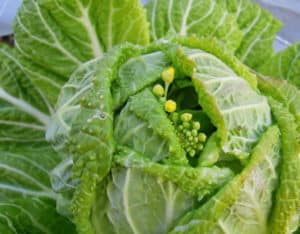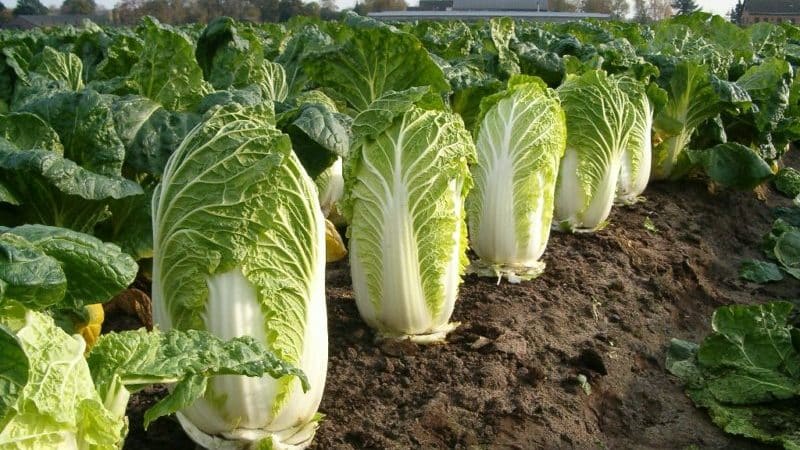How to determine that Chinese cabbage is getting ready to bloom, and what to do if this happens
Chinese cabbage is a tasty and healthy plant, ideal for salads. He cannot be called picky. If the rules for growing are followed, the harvest is obtained 2 times per season. However, due to certain factors, the heads of cabbage may shoot arrows and bloom, which leads to loss of taste and the entire harvest. To prevent this from happening, it is important to understand the causes of flowering and figure out how to avoid such a problem.
Why Chinese cabbage bloomed: reasons
Chinese cabbage appeared in Russian gardens relatively recently, but this did not prevent us from establishing the most common reasons for its flowering:
- When planting, the soil was not heated to the required temperature. Chinese cabbage is a heat-loving plant, so in cold soil it experiences stress, fruit formation begins earlier and rushes to complete the cycle as soon as possible.

- Long daylight hours. This plant loves shade, therefore, being under the sun's rays for a long time, the heads of cabbage shoot out and bloom.
- If the plant is planted as seedlings, there is a risk of damage to the roots. This can also happen when the soil is loosened. Having lost part of the root system, the plant experiences a lack of nutrition and shortens its life cycle, trying to leave offspring.
- Unsuitable climatic conditions also provoke flowering.Therefore, you should plant varieties adapted for Russian weather on your site - Bilko, Manoko, Taranko. For high-quality seed material, contact specialized stores. Check seeds before planting for sterility, damage and signs of disease.
- Chinese cabbage loves water, so a lack of moisture provokes flowering. Make sure the soil is always slightly moist.
- Flowering occurs if, at the time of head formation, the air temperature drops below +22°C. Optimal values are +23…+27°C. If it gets sharply cold outside, use agrofibre.
- If you planted Chinese cabbage after cruciferous vegetables, it will go into color. The best predecessors for Pekinka are legumes, onions, cucumbers and tomatoes.
- The problem will manifest itself if there are not enough nutrients in the soil when planting the vegetable. Chinese cabbage reacts especially acutely to a lack of calcium, potassium and phosphorus. Therefore, before sowing seeds or seedlings, organic and/or mineral fertilizers are added to the soil. For example, 30 g of eggshells are infused in 5 liters of hot water.
- When choosing a variety, keep in mind that hybrids with low resistance to cold most often bloom.
- Chinese cabbage should be harvested without delay. Otherwise, dense heads of cabbage will inevitably fade into color, spoiling the taste.
It is recommended to plant Chinese cabbage twice per season. The first landing is April 15-20. The second is from July 20 to August 10.
What to do if Chinese cabbage has started to bloom
If the plant shoots an arrow, the head of cabbage cannot be saved. In this case, it is removed, and a new sprout is planted in the vacant space.
To protect neighboring plants, determine the cause of the flowering and try to eliminate it before the rest of the cabbages in the garden bloom. This will save the crop and prevent the problem from reoccurring.
How to tell when cabbage is about to bloom
The main signs of this phenomenon:
- stopping the plant from developing and growing;
- withering and yellowing of leaves;
- new leaves do not form, the vegetable stops growing in width and sharply stretches upward.
Prevention of flowering

To prevent crop damage, follow these recommendations:
- Plant the plant near buildings or a fence that will provide it with shade. Chinese cabbage needs short daylight hours. If it is difficult to find shade on the site, plant cabbage in an open area, but in the afternoon, use covering material or create a structure of arcs over the bed, over which stretch light-transmitting material. Chinese cabbage grows well in greenhouses next to tomatoes and cucumbers.
- Follow the planting deadlines mentioned above. At first, the cabbage can be covered with agrofibre; it will ensure that the optimum temperature is maintained.
- For planting, it is better to use frost-resistant Dutch varieties. Among them are Manoko, Optiko, Mirako, Starko, Bilko and Taranko. The domestic hybrid Khibinskaya 5 and the Japanese variety Kyustar rarely bloom.
- Seed material is sown directly into open ground or peat cups. When loosening the soil, touch no more than 2-3 cm, so as not to damage the delicate root system.
- A month before planting seeds or seedlings, mineral fertilizer in the form of superphosphate or potassium sulfate is added to the soil.During the growing season, mineral complexes for cabbage are used, which can be purchased in specialized stores.
- Before planting Chinese cabbage, the beds are sprinkled with wood ash, which prevents the appearance of shoots and also protects the plants from pests and serves as feeding.
Is it possible to eat cabbage leaves that have gone into color?
Leaves during and after flowering acquire a bitter taste and become rough. Therefore, such a product is not eaten either fresh or after heat treatment.
Salting or soaking in salted water will not help correct the taste of cabbage. In this case, cabbage loses all its beneficial substances. But it can be used as food for pets, if there are any on the farm, or composted.
This is interesting:
Diet for weight loss using Chinese cabbage: principles, approximate diet, reviews and results
Conclusion
Chinese cabbage blooms due to disturbances growing rules.
Due to low temperatures, lack of fertilizers and moisture, long daylight hours and mechanical damage to the root system, the heads of cabbage shoot arrows and begin to bloom, and the leaves become bitter.